
 |
Abrasion
Resistant Fabrics,
Common and Exotic fibers
used in building wood strip kayaks and composite shells. |
| As strong as wood strip kayaks are, their thin fiberglass skin is not as forgiving of abuse as polyethylene or kevlar hulls. What can be done to protect the hull? Most builders resort to extra layers of fiberglass on the keel line and to other lesser known abrasion resistant fibers such as Dynel, Olefin, Xynole , Syntex or S-glass. As with any material, however, there are advantages and compromises. |
The Good |
Much of the material's abrasion/impact resistance comes from its polymer structure, namely its elasticity and toughness but in some cases also from the twist of the individual threads. Both of these properties are exploited the same way in rockclimbing ropes, for example. On impact or a load, the fibers stretch like coiled springs but do not break, thus absorbing large amount of energy gradually. Since the fibers are more elastic then the more brittle e-glass, the skin will bruise but will not rupture, keeping water away from the wood core. |
The Bad |
On impact, the elastic fibers stretch far from the point of impact and separate from the epoxy. This creates sizable scars (far larger than in e-glass) obscuring the wood completely. The material's claim to fame is also its 'abrasion resistance' which coincidentally makes the fuzzy surface very tough to sand and fair smooth. Last but not least, the fibers do not wet out as clear as fiberglass. |
The Ugly |
Many of these cloths (with braided threads) soak-up monstrous amounts of resin. Unlike the straight strands of fiberglass, the twist of the fibers gives the cloth more 'thickness'. This allows the 4oz. fabric to swell and hold enough resin equivalent to 2 or 3 layers of 4oz. glass. Trying to squeeze the resin out with a squeegee as in fiberglassing just makes things worse by whipping in a lot of air bubbles obscuring the wood even further. |
| Conclusion | With the exception of s-glass, I seldom use them. To me, the benefits do not justify the drawbacks, particularly the epoxy weight and labor. I prefer to add few more layers of normal e-glass or s-glass on the keel line for the same effect. |
| Synthetic fibers |
| . | Click on images for magnified version. | ||
| . | 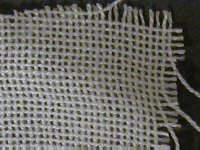 |
Dynel
- 4.2oz. Good abrasion and impact resistance but the lay-up is epoxy rich and the fabric is rather opaque. |
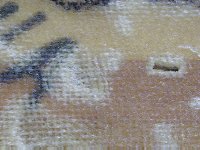 |
| . | 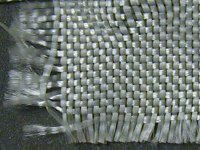 |
olefin
- 4oz. Polypropylene Excellent impact resistance. The clear wet-out is the best of the group, almost like fiberglass but the scarification on impact is the worst of all fabrics tested. Fibers are not twisted. |
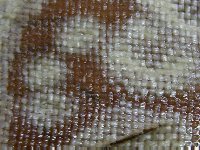 |
| . | 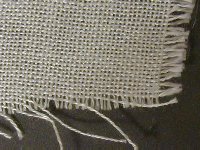 |
Xynole
- 4oz. Polyester Results identical to Dynel. |
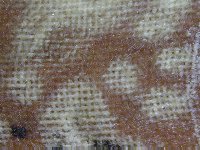 |
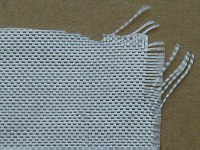 |
Syntex
- 2.8oz? This innocently looking stuff (looks like Olefin) is as hard to
cut with scissors as Kevlar!! Syntex seems to be a material with Kevlar-like properties (abrasion and puncture resistance) but which wets out as clear as plain fiberglass. It also has one of the highest strength to weight ratios. |
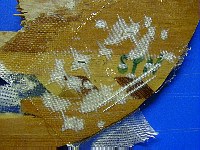 |
| The bruising pattern seems to be unique as well. While other abrasion fabrics show a round scar, Syntex has a 4 point star shaped pattern. This bruising in the principal directions of the fibers far into the epoxy matrix indicates that the fibers also absorb a huge amount of stress before failing. Compare that with the fiberglass punctures in the picture below (right). The brittle glass fibers sheer off before they have a chance to absorb much loading. Note that this test is done only with one layer of the material. The fabrics with the highest impact resistance have also superior sheer strength. That is why Kevlar and Syntex are nearly impossible to cut with normal scissors. |
| . | 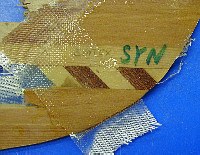 |
The
left picture shows how nicely syntex wets out on a scrap of cockpit cutout.
The small patch on top is one layer of 6oz. fiberglass. The right picture shows impact test ( plywood is the substrate). Plain syntex is on the left, syntex + 6oz. glass is in the middle and plain fiberglass to the right. Click on the picture for close up view and note how the fiberglass failed to stop the screwdriver punctures but the patch of syntex did not yield (only the epoxy skin is crushed. |
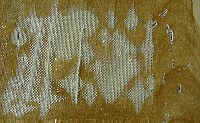 |
| Fiberglass fabric weight is in ounces per square yard Fiberglass is the most widely used material in boatbuilding. Even though its physical properties are quite average with respect to the high tensile fibers, it is inexpensive and is the only practical material for reinforcement of clear coated wooden boats and in glassing wood strip kayaks |
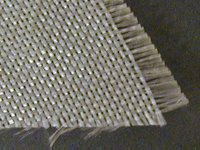 |
E-glass-
4 oz. 22x24 weave This is a normal plain weave fiberglass used for kayak deck. This material was used as substrate under the abrasion fabrics. The right picture shows impact resistance of 2 layers of 4oz. Glass This fiberglass and its 6 oz. counterpart are the staple of wooden kayak building. |
 |
|
| . | 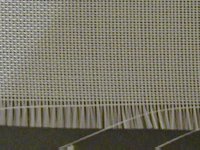 |
E-glass
- 4 oz. 40x40 weave Higher thread count (pick) and tightly packed strands. This cloth is harder to wet-out than the 22x24 glass. Use low viscosity resin or warm it up before lay-up to get completely clear coat. This fabric was used for the Epoxy Test panel. |
|
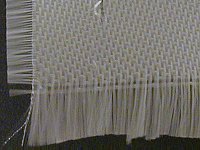 |
S-glass
- 4 oz. The strongest type of fiberglass with the best impact and abrasion resistance.Tight weave makes this glass nearly impossible to wet-out clear. Used only as tape on keel line and hidden reinforcement. |
| Carbon | |
| Carbon has the highest Modulus of Elasticity (stiffness) of all boatbuilding fibers. The fibers are very strong in both tension (three times that of steel) and compression. It has about 60% of the density of fiberglass but is slightly heavier than Kevlar. Carbon fabric is very easy to work with and in many respects, it handles like plain fiberglass. The disadvantages are poor sheer strength ( low impact and abrasion resistance). Graphite fabrics are best included in protected areas where strength and stiffness are very important. I use carbon extensively for building rudders, cockpit coamings, hardware such as lashing hooks and tubing and internal reinforcement. |
 |
Carbon
5.8oz. twill 2x2 weave (left) Superb for coaming, cockpit reinforcement, components and where stiffness and good looks are desirable. Handles just like 6 oz. fiberglass. 5HS cloth 10oz.(right). |
||
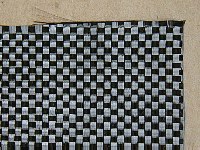 |
Plain
weave Carbon - 5.7 oz./ sq. yard 12.5x12.5 weave HEXCEL AS-4 fiber |
||
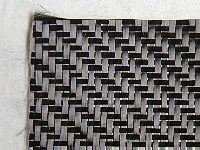 |
2x2
Twill Carbon - 5.7 oz./sq. yard 12.5x12.5 weave TORRAY T-400 fiber |
||
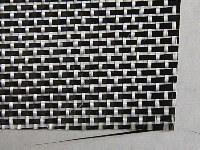 |
Unidirectional
Carbon w/ S-glass- 3.5 oz./sq yard 12x12weave Plain weave, carbon - warp, s-glass - fill |
||
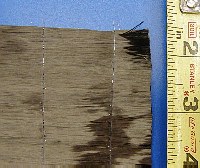 |
Carbon fibers (unidirectional) 10oz.- bonded together with plastic 'melt-on' threads. They dissolve in polyester resins but not in epoxy. For high performance applications with epoxies, the cross-stitching is usually made of interwoven threads of s-glass so that the fibers can move and straighten freely. I use it with epoxies anyway because it is good enough for construction of coamings or behind the cockpit under the deck. Because of the straight path of the threads, it has unmatched tensile strength and stiffness in the direction of the fibers. Unlike the glass stitched type, the fibers do not unravel easily, which is the best feature by far. | ||
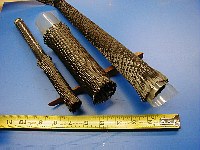 |
Carbon
sleeves Ever wondered about the 'seamless' construction of rowing shell riggers, oars, paddle shafts and other 'tubular' components? These specialty sleeves make it possible to construct tubular or conical components of lightweight and very high strength. The main advantage of these sleeves is in the speed of manufacturing as well as uniform distribution of stress in the components. The fibers are continuous and stay symmetrical to the axis of the molded shape as well as to each other which is impossible to achieve by simple wrapping of fabric on a mandrel (mold for tubes or cones). See how to make low tech carbon tubing. |
The
left and middle sleeve fibers run at bias to the axis of the tubes. The
small sleeve can be used for tubes 3/4" to 1.25" in diameter.
The angle of the fibers with respect to the axis changes as the diameter
of the tube changes. This makes the thicker tube stronger in torsion, while
the thinner tube would become stronger in tension and compression along
the axis. The sleeve on the right is made of heavy unidirectional bundles interwoven with elastic threads. This sleeve can contour most conical and tubular shapes. The cone in the photo goes from 3/4" to 1.5" |
| Kevlar and Kevlar / Carbon blend | |
| Specialty fabrics that exploit the abrasion and puncture resistance of Kevlar and stiffness of carbon. Kevlar has the highest tensile and sheer strength (superb puncture and tear resistance) as well as the lowest density (mass per volume) of all boatbuilding fibers. The disadvantages of Kevlar are poor compressive strength (fiberglass is almost twice as strong in compression) and difficult handling (cutting and sanding). It is also hydroscopic, so in its raw state, it must be kept away from moisture at all times. Kevlar is also effected by UV light and changes color over time from nice golden yellow to dark mustard brown. |
| Home | Kayak Designs | Kayak Shop | Materials | Kayak Gallery | About us |
| Building Manual | Plans | Sandwich Core | Wood Kayak | Order | |
| Epoxy Test | Abrasion Cloth | Rudder | Resources | Choosing Kayak | Guestbook |
If you notice any problems with the site (i.e. error links, missing images) please, let me know. Thanks
Mail:
Vaclav Stejskal
10 Colonial Court apt. 73
Stoneham, MA. 02180
USA
Tel: 781-481-9261
© 1999
- 2020 Copyright Vaclav Stejskal
All rights reserved
Last page update:
11 January 2020